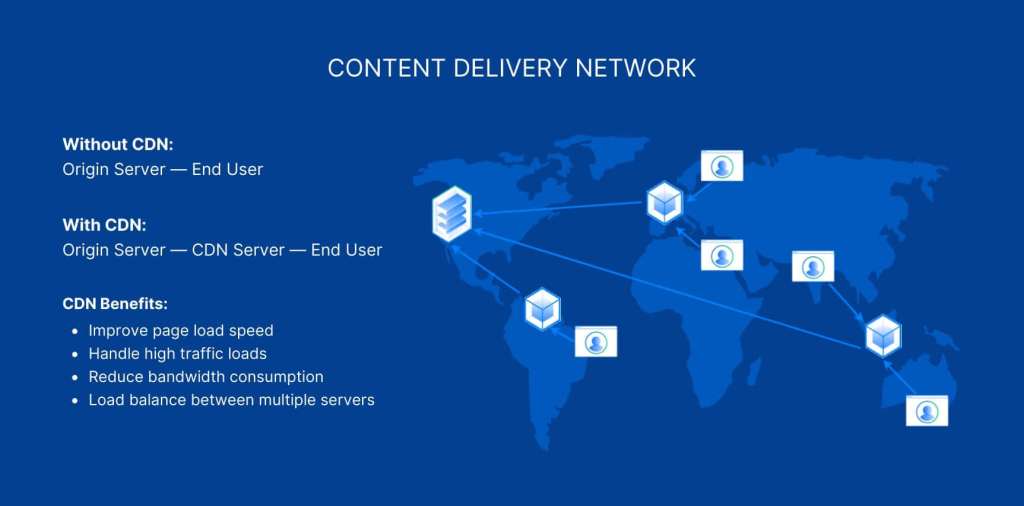Understanding a CDN
The primary goal of a CDN is to reduce latency—the delay that occurs from the moment a user requests a website until the content appears on their screen.
Typically, when a user accesses a website without a CDN, the request travels all the way to the site's original server, which could be located on the other side of the globe.
CDNs solve this issue by storing cached copies of the content on multiple servers around the world.
How CDNs Work
CDNs consist of a network of servers located strategically around the globe. When a user requests content that's part of a CDN, the request is routed to the closest server in terms of network latency.

The server, known as a CDN node or edge server, then responds with the cached content.
Key Components of CDN Architecture
- Origin Server: The central repository of the website's original content.
- Cache Servers: They store the replicated content at various points in the network to ensure faster delivery.
- Points of Presence (PoPs): Physical data centers where CDN servers are located to reduce the distance to the end user.
Benefits of Using a CDN
There are multiple reasons why utilizing a CDN can be advantageous for a website or online service.
Improved Load Times
CDNs can dramatically improve the load time of a website or application by serving content from the nearest server to the user, thereby reducing latency and the time it takes to serve content.
Scalability
A CDN can handle a surge in traffic by distributing loads across multiple servers, making it easier to manage traffic spikes without compromising performance.
Enhanced Security
CDNs provide various security benefits, such as protection against DDoS attacks, secure token authentication, and data encryption to help safeguard content and personal data.
Types of Content Delivered by CDNs
CDNs can handle various types of content, from simple text and images to complex multimedia files.
Static Content
This includes files that don't change often, such as CSS files, JavaScript, images, and videos. CDNs are highly effective at caching and quickly delivering this type of content.
Dynamic Content
Unlike static content, dynamic content is generated in real-time and can change with each user request. Modern CDN services have evolved to efficiently handle dynamic content as well.
Choosing a CDN Provider
Not all CDN providers are the same, and the selection depends on the specific needs of your website or application.
Key Considerations When Selecting a CDN
- Network Size: The number of data centers and their geographic spread.
- Performance: Speed of content delivery and load times.
- Reliability: Uptime guarantees and redundancy measures.
- Cost: Pricing models and cost-effectiveness for your needs.
Popular CDN Providers
Some of the industry-leading CDN providers include Akamai, Cloudflare, and Amazon CloudFront. Each comes with its unique features and pricing structures.
Best Practices for CDN Implementation
Implementing a CDN effectively is crucial to reap maximum benefits from the service.
Cache Control
Setting proper cache control headers ensures that the CDN caches the content for an optimal period, helping to manage the bandwidth and reduce server load.
Content Compression
Compressing content before it is delivered through CDN servers can further speed up load times and reduce data transfer costs.
Regular Monitoring
To ensure optimal performance, it's essential to monitor your CDN's effectiveness regularly and make adjustments as needed.
Conclusion
CDNs play a crucial role in the modern internet landscape by enabling faster, more efficient, and more reliable content delivery.
Whether you're a small blog or a large enterprise, implementing a CDN can bring about significant improvements in your website's performance, user experience, and security posture.
With the ever-increasing demand for quick and reliable digital content access, harnessing the power of a CDN has become an essential component for any online presence.